The Rule of Law
January 16, 2011
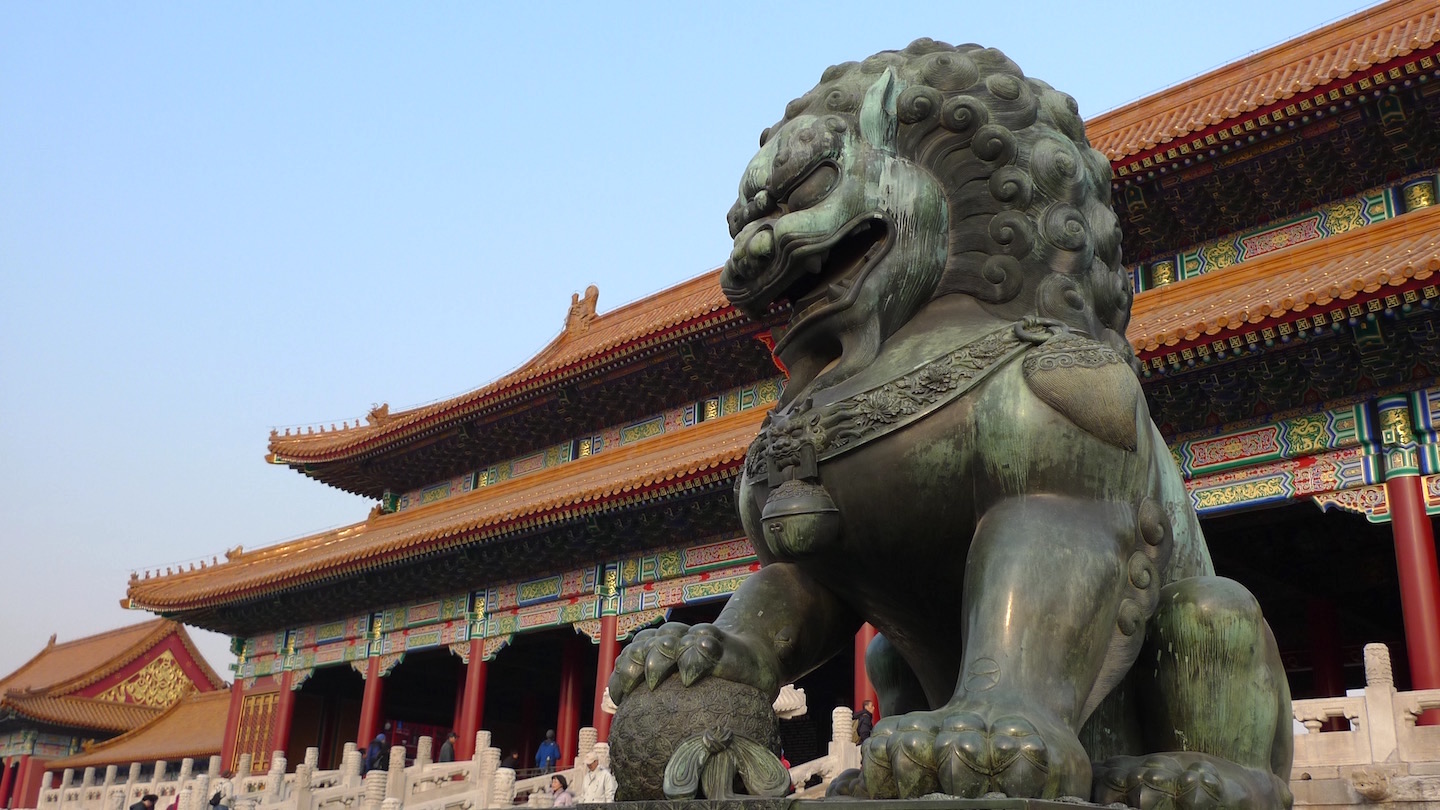
A bronze dragon spans a globe with clawed foot in Beijing’s Forbidden City. The complex dates from 1406.
It’s next time again.
Which of your freedoms have you thought about lately? Your right to create almost anything you want, and then own the rights? Your right to disagree with your government? Surf the internet? Sue somebody if you feel yourself to have been wronged? All this stuff I never gave a second thought. And then I went to China.
Don’t get me wrong. China has changed and it has changed a lot. In a mad rush to modernize, the government has allowed certain things while censoring others. If an international paper has a certain story the government feels is guilty of “China bashing” – the paper does not come out that day. Certain websites are disabled or disappeared. (For a recent NYT article on this click here.) There is a pervasive feeling of Big Brother but there is also a sense of hold your breath excitement; that China has arrived as the newest superstar on the world stage and is about to deliver a once in a lifetime performance. The rickshaws and coolie hats are long gone. Conspicuous consumption abounds.
I was sent there for work by a wonderful client who is working hard to define and implement the Rule of Law around the world. The client is Jones Day and they are one of the largest law firms in the world. Their mission has an obvious self interest but having worked with them for many years now, it also seems to me, at their core, there is a healthy dose of genuine passion and higher purpose. These are incredibly smart people filled with the infectious enthusiasm of doing what they love.
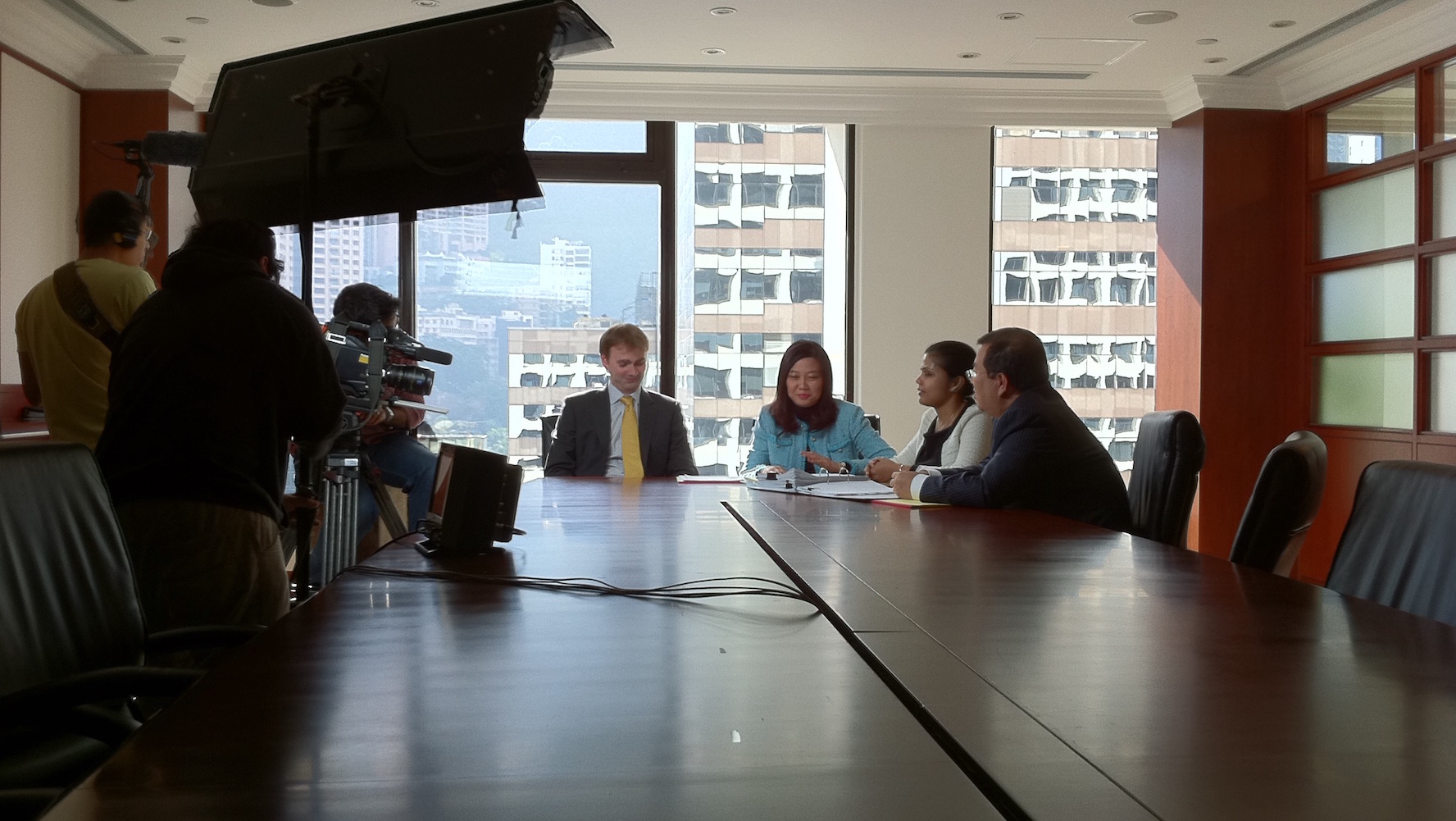
The Jones Day offices in Hong Kong are in the middle of the financial district. The Hong Kong stock exchange is the second largest in Asia predominantly because it handles most of the international transactions for China. This is because Chinese currency is not freely traded.
My mission was to do some videos to explain what Jones Day is doing in Greater China? We interviewed very smart people with lots of experience and I marveled at their ability to keep pace with such a rapidly changing society. Let me give you some examples.
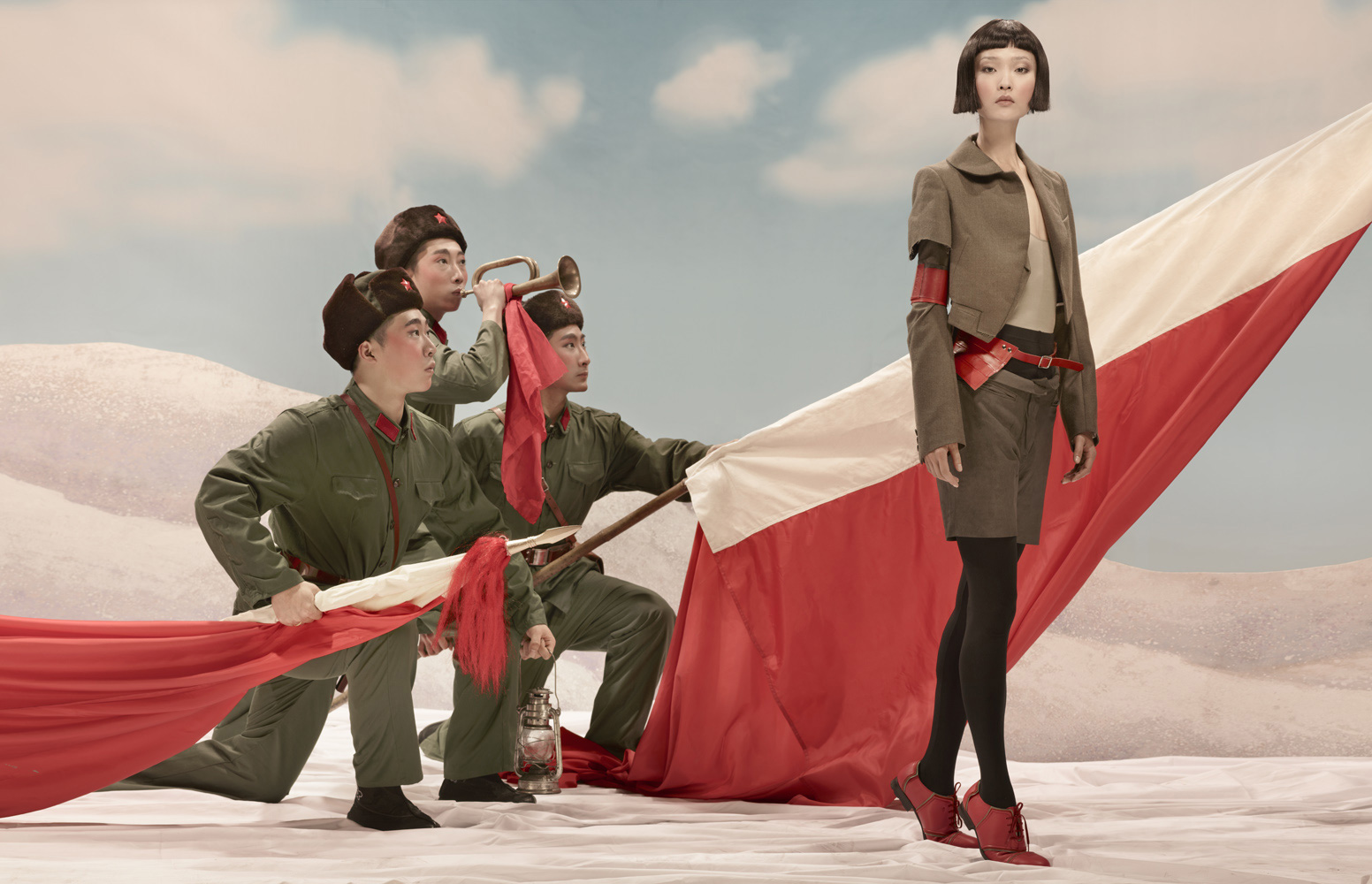
Inspired fashion designers and photographers use tradition to make a modern statement. Here, the extremely talented Quentin Shih, offers a new take on the Revolution for Vogue China, 2011 Check out his superb work by clicking on the photo or his name.
China has tossed off the Mao-styled twill uniform (except as an inspiration for fashion) and put on the Brooks Brothers suit. It is embracing all the most crass and disturbing elements of Capitalism. Being there around Christmas time was extremely disorienting. Bad hillbilly Christmas carols is not what I expected in glistening shopping malls filled with every luxe brand you can imagine. Dior, Louis Vuitton, Prada, Gucci, Chanel, you name it, they were there with bells on. Santa Claus was everywhere, sometimes next to a giant panda. There was nothing even remotely religious about any of this. It was all just vulgar American-style, make-a-quick-buck commercialism; just the sort of thing I hope to escape by traveling outside the U.S. at Christmas time.

Luxury brands are making a name for themselves in China. Couture is big business in Beijing’s ultra-modern ultra-chic shopping malls featuring all of the major European designers.
Many contemporary architects have projects in China. Some of these buildings became instantly world famous during the recent Olympics. When you land in Beijing, if you come from Hong Kong, you leave from a spectacular Norman Foster airport and arrive at an even more spectacular Norman Foster airport.
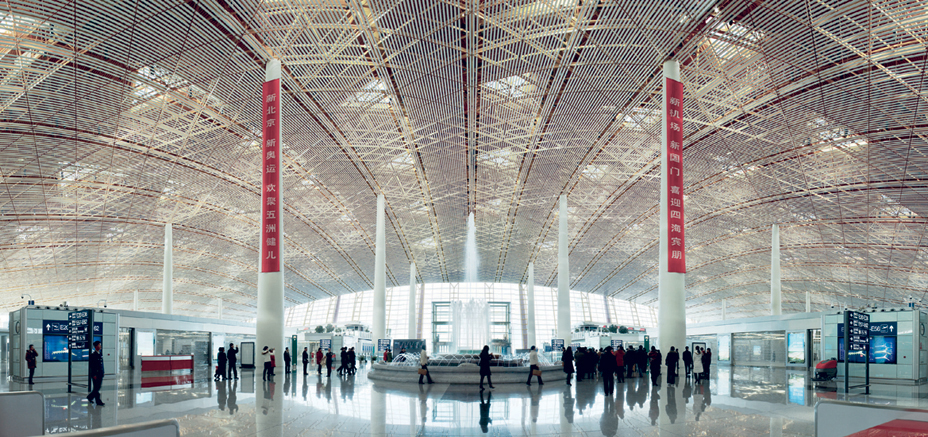
Sir Norman Foster’s Beijing airport is perhaps the largest roofed structure in the world. The effect is breathtaking. Photo courtesy of Norman Foster Partners.
His Beijing airport is the largest roofed structure in the world, the size of over 140 football fields! The roof seems as vast as Wyoming and you cannot help but wonder, where in the world did he hide the HVAC? In talking with people who travel in and out of there all throughout the brutally hot summer, they wanted to know the same thing. Climate control aside, the structure is gorgeous and the point is made. Upon arrival you know you are someplace affluent, modern and very special.
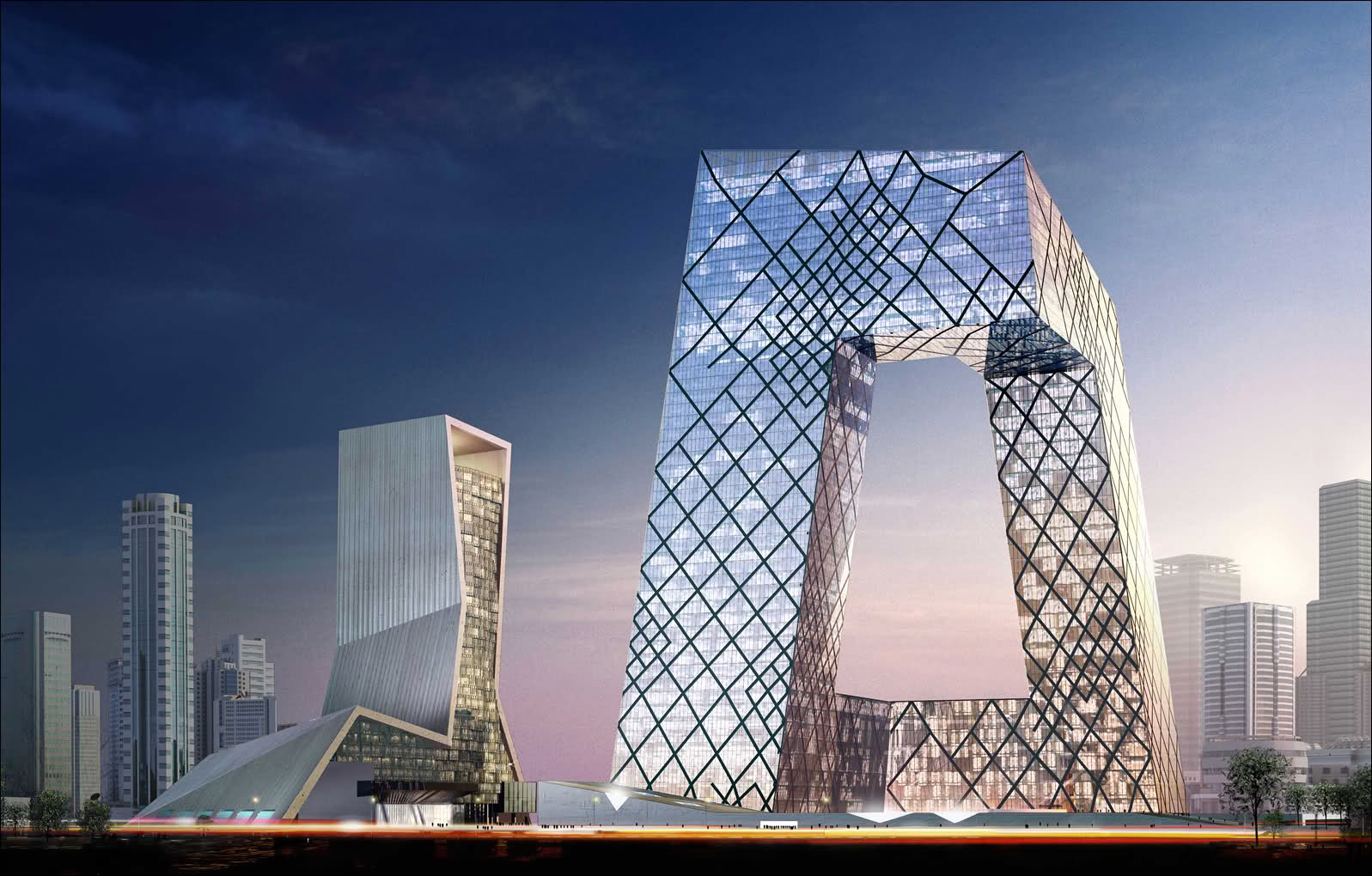
A rendering of Beijing’s stunning Central China Television Headquarters designed by Rem Koolhaas and Ole Scheeren. The building thrills but is perhaps the largest piece of vacant real estate on the planet
A massive and highly creative Beijing project is the new CCTV building designed by Rem Koolhaas and Ole Scheeren. This building is deceptive. It appears to be just remarkably innovative with its distinctive shape and grid design but it is also incredibly gigantic. It is uncanny; but something about the design allows the building to scale itself perfectly into the urban landscape. People in “the Jing” as my cameraman referred to the city, call this building, “The Pants” or “Big Boxer Shorts.” Although you would never guess, this building encloses more than a million and half square feet. It is bigger than the Pentagon for Christ sakes and if you stacked its wings on top of one another it would be one of the tallest structures in the world. Bravo! But there was a problem.
A companion building adjacent to the complex was destroyed in a catastrophic fire during the final phase of its construction. This has delayed occupancy of the main building for years to come and has spawned worries about its stability. The burned-out building was supposed to provide vital counter balance to the main structure’s foundation. It seems that a celebration for the eminent completion of the project also included fireworks. The fireworks caught the insulation for the building on fire. Why is this unusual? Think about it. Insulation in the United States is not flammable, no OSHA inspector would ever allow such a thing. Enter the Rule of Law. The architects became clients of the Firm after the fire put the project into legal and liability turmoil. When was the last time you thanked OSHA for anything? I take them totally for granted, if not a source of bureaucratic irritation. As I thought more about this, all I can do is count my blessings. It seems horribly cliched but the freedoms and protections all assured to me by the Rule of Law in which I blithely live, effect almost every aspect of my life and I pay them no respect at all. They are as under-appreciated as the air I breathe.

Rush hour in Beijing is a bumper-to-bumper smoggy nightmare worthy of L.A. This photo was taken from the roof of the office tower where Jones Day Beijing resides.
Which brings me to the air quality in Beijing. When was the last time you gave a second grateful thought to the EPA? During the winter months the dry air sweeping into “the Jing” from Gobi Desert picks up all the pollution from the city’s centralized coal-fired heating plants. This, coupled with the exhaust from 4 million cars (and I have read estimates that this number grows by 2,000 vehicles a day) produces over 51 million tons of pollutants every year. The dry smoggy air gives you a persistent hacking cough, watering itchy eyes, a vague sore throat, and an irritable disposition. Almost every person we interviewed had a humidifier in their office.
You think our roads and automobile industry is over regulated? I was astounded by the traffic. Bumper to bumper does not begin to describe their rush hour. How do I know this? We got special permission, as our last shot of the last day, to go up on to the 37th floor and access the roof of the building. We shot a sequence worthy of the time-lapse-filled masterpiece Koyanasquatsi. Imagine my surprise and delight when this exact same view was featured on page 2 of the Financial Times last week in an article about the massive automobile glut in China.
My visit was not completely filled with Western-style urbanism. One of the few truly Chinese cultural mind blowers were early morning visits to the Forbidden City and the Temple of Heaven. What sticks about both of these landmarks is the scale and the empty space. The stone courtyards are immense and their stunning impact is not blunted by landscape.
There are plantings but green spaces are primarily restricted to vast gardens. Cypresses from literally 500 years ago. They are planted endlessly. You wander through the gardens and get lost in the forest. But the two experiences are kept separate, like proper courses in an elegant meal. They are different, and because they are so completely separated, they each retain their impact. You walk out of the cold empty stone spaces into a forest. Your body reacts to this with a relaxing sigh as you leave the city down a sloping incline of grooved stone and enter a flat gravel garden pathway outside the containment wall. These inclines are much easier to navigate than steps. Your feet feel solidly held by the grooves and the slope is not too steep. Even so, your strides become restricted to accommodate the slope. You sense legions of warriors on horseback have proceeded your shortened footfalls by 500 years.

Some of the Cypress trees outside of the Temple of Heaven in Beijing are said to be over 500 years old.
I should emphasize all of these superficial thoughts are just first impressions from a very brief trip. For those of you who really know China this must sound like someone who makes generalizations about Europe after changing planes in the Paris airport. Spending two hours in the Forbidden City is like spending ten minutes in the Louvre. It was just a taste. But it is the sort of knock your head off experience which burns itself into your memory. I could not forget that if you were a peasant in feudal China this was impossible to see. Those that breached the walls had their heads cut off. The historical inequities between the elite status of the rulers and the rest of the country is mirrored in today’s experience of Beijing. The designer boutiques are for the rarified few in China (and of course for the foreign tourist).
China in the 19th and 20th centuries has gone through incomprehensible social change. Is there a more disgustingly arrogant example of the evils of Capitalism than the Opium Wars? No wonder this society was fearful of the West and its corrupting influences. The unimaginably brutal repressions of the Cultural Revolution and the enforced police state of the Communist regime, turned the Western World into a forbidden civilization. Now, as China opens up once again to all the West has to offer, one can’t help but wonder what is the ultimate plan? Is there one? Is seemingly unbridled Capitalism the best hope for China and it’s 1.4 billion people? Greed-is-good Capitalism at least glorifies the individual who then wants rights and freedoms. One thing is for sure. The Rule of Law can only help a society as it transitions from authoritarian control to an inevitably more Democratic system. I had never so palpably realized how the legal system protects and defends Freedom. The legal profession gets beat up pretty badly in the popular psyche. It was a pleasure to consider its more noble purpose by such vivid examples of where we would be without it.





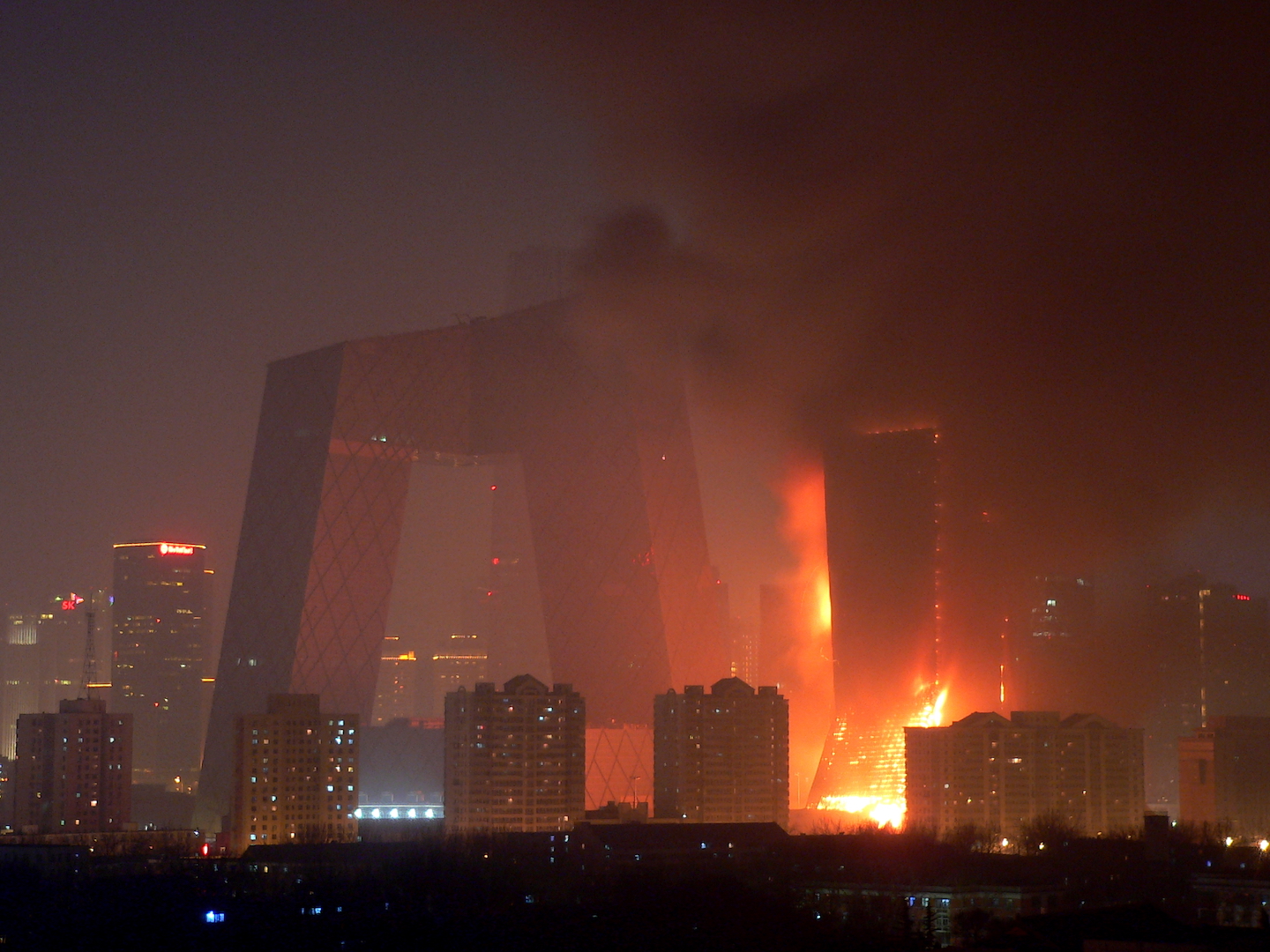

6 Comments
When I grew up in the Los Angeles basin in the 50s and 60s, the “smog” was bad. How bad was it? When my Dad drove the family on the Hollywood freeway on a bad day, the bumper of the car in front of us was barely visible, and we were unable to see two car lengths ahead. It looked just like fog and as a child, I thought it was fog. How bad was it? We had a garage but Dad used it for a variety of projects he always had going. So he parked his car in the driveway. Most mornings he used the garden hose to wash down the windshield before he left for work. A black sooty-like substance collected overnight. How bad was it? On the worst days, the air raid sirens and emergency radio frequencies were used to notify residents that all non-emergency vehicular traffic must pull to the side of the road immediately until further notice. Those with serious breathing problems were told to report to a nearby hospital to obtain oxygen treatment. How bad was it? On some days, while playing in the yard, I would suddenly realize that my chest hurt. It felt like someone had slugged me in the sternum and I found it impossible to take a deep breath without coughing. Mom would call for me to come inside. How bad was it? I travelled to Beijing eight months prior to the 2008 Olympics. The evening I arrived I was scratchy eyed and could only think of sleep. The next morning, I opened the curtains of my hotel room in the business district. I couldn’t see anything across the street, in fact, I couldn’t see more than about two feet. I exclaimed to my husband, “I haven’t seen smog this bad since I was a little girl!” Officially, LA claims to have cleaned up by 400% since the 1960s (thanks in part to the mandates of the Clean Air Act) but they still receive poor air quality ratings. It is reported that the number of Stage 1 smog alerts has declined from over 100 per year in the 1970s to almost zero today. Despite improvement, the 2011 annual report of the American Lung Association ranked the city as the most polluted in the U.S. and ranked LA was ranked 2nd in the highest year-round particulate pollution (in other words, it doesn’t ease up with good days and bad days, it is pretty much bad all all of the time)(#1 was Bakersfield, CA). Today, Beijing beats LA hands down as far as air pollution is concerned. The “smog” in LA can be very bad, but there are not as many factories within the city boundaries in LA compared to Beijing, and the number of inhabitants are also lower in LA. The west wind can often blow sand from the Gobi Desert far into the city of Beijing itself. Cars there are often covered in fine, yellow sand in addition to smog and ash particulates.
Great post about Beijing. I love seeing the world through your eyes!
Dear Tom,
I can’t answer your great blog, without thinking of the destruction of Egyptian antiquities showed on TV recently. Fortunately it seemed to have been just a couple of rooms that were affected, but it reminded me the fragility of art when there are acts of desperation. It’s not only what’s happening now in Egypt, but mankind should protect their treasures. Nevertheless, history seems to be always repeating itself.
Freedom of course is great, but as an artist, I see how censoring brought wit and ways to go around certain subjects in for example, Hollywood in the late 30’s, 40’s and 50’s. Nowadays, one sees a movie, and sometimes it gets terribly graphic, and the dialogue lacks the cleverness of the past decades mentioned. Sometimes when one is limited in an art project, your brain starts acting up and trying to find ways to express the emotion and goal, under the restrictions. The testament of time will show how certain art forms, like architecture, fashion,and so on, will have a lasting effect.
Your China experience sounds amazing. I look forward the day that I’ll be able to go.
Thank you for sharing such great photos and stories.
Juan
Tom, your description of Beijing was evocative and perfect, identical to the Beijing that Mark and I experienced several years ago. We attended an international photo review session in Beijing as reviewers. The photographers were juried but application was open to any photographer anywhere in the country — a first in China where opportunities are usually limited to members of the government-run artists’ organizations. One of many insights we took from the photographers’ works and discussions was that there is not one China, there are many. Beliefs (religion or political), living conditions, social values all vary depending on one’s economic class, part of the country, ethnicity (there are many in China) and many other variables. It is a fascinating country but far less monolithic and stable that it usually appears in the U.S. press.
Dear Tommaso,
This is a great reflection! I am married to a lawyer, and we just saw the movie “the King’s Speech” — a very great movie about the teacher who helped the Duke of York with his stammer, just as Hitler is rising in Germany, and his older brother prepares to abdicate the throne. I kept thinking about the way the character of Bertie is portrayed; how his love of history and his sense of duty impel him to be a better speaker– he is courageous although he is humiliated and goaded, and suffers cruelty, he is also encouraged by a loving wife who wants to help him. The most riveting scene is when he is in Westminster Abbey, and shouts in full-throttle anger his reasons for why he has a right to ascend that throne. There is a deep sense of duty, of love of right, of care for the legacy of his father, and care for the people for whom he will be king. I was thinking that many people in our time have really acted like the older brother– shirking the sense of history and duty, and being interested only in enjoying life, in self-indulgence or self-expression.
The Chinese have such a long and strong memory– or they did, until this modern time. The Forbidden City seems immense and time-immemorial. It dwarfs the individual’s plans and hopes and thoughts. At best, the rule of law is to carry that memory of historical precedents, to bend the way things are done, to process them, in a way that may minimize mistakes of the past. You mention several foundational ones– especially meaningful to me is the point about air quality. I know a pulmonary specialist who got himself appointed to the Air Quality Board for the state of California, so that he could “weigh in” when it was possible to do so, informing the politicians about the importance of the laws against pollution on childhood asthma, among other pulmonary diseases. He was positively joyful when they passed a regulation about fireplaces and prohibiting the use of burning wood– reducing air pollution significantly in one fell-swoop legally for the whole state!
The new architecture in Beijing is amazing, and that photo of the traffic from the roof of the building is proof that they are at the front of the 21st century expansion! Today I heard on the tv a very scary line from Hernan Cortez, when he first landed in Mexico; “Burn the boats! Fight or die.” There was no quarter, no hope of surrender with honor, no possibility of retreat. The Chinese are grinding out the new world, and a lot of people are being “grist for the mill”. A hundred years from now, it will maybe be time for some cultural reconnaissance, wondering about the price they paid for this period. It is good that an international law firm is trying to help “write the rules”. Maybe some grave mistakes will be avoided.
The most worrisome thing is that the Communist Party elite will set laws aside when it is convenient to them. For the rule of law to truly hold, no one political group can have all the power. It has been abundantly made clear by the history of totalitarian communists in the USSR that human rights don’t matter to the all-powerful state.
Our government was created to maintain a balance of power, to PROTECT the citizens from the power of the state. Our constitution is one in which individual rights cannot be abridged, and the people should be SERVED by the government. Unfortunately, although it has been tactfully proposed that the Chinese should honor human rights, it is not likely at any time soon that they will do so. We should really be aware that this is “alien” to our way of thinking, and dangerous for individuals who love freedom. Meanwhile, like in the wild west, there are some very powerful people who can say “I AM the law here!”
hello Tom,
Having never been in China and always picturing a colossal Walmart with factories the size of Texas and pollution in the water, air and earth enough to kill all living species; it was
good to read your very interesting and informative entries.
I just read The Good Earth again after about 40 years and my how times have changed over there. Thank you for all your astute observations in all that you see and do. I love reading your blog.
hello tom,
thanks for sharing such a remarkable toe-dip moment in today’s china. it’s clearly the power to be reckoned with of this current century. i see you as the cleveland- and no accident- venice based, marco polo to this exotic land, who returns to share the vivid, spicy and very intelligent impressions from what is clearly an amazing country. makes me all the more eager to follow in your trail, in the not too distant future.